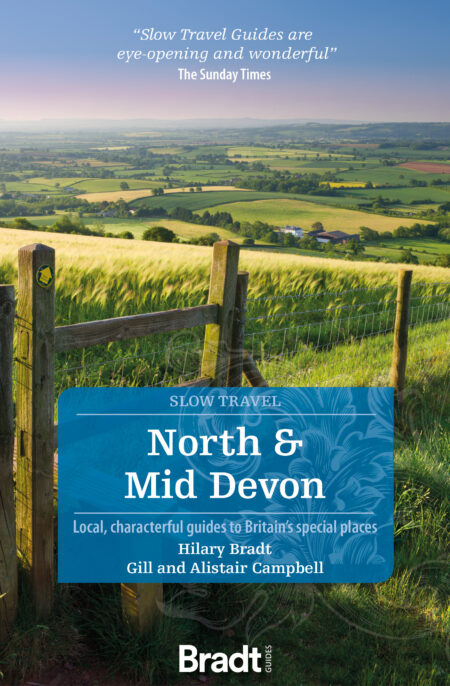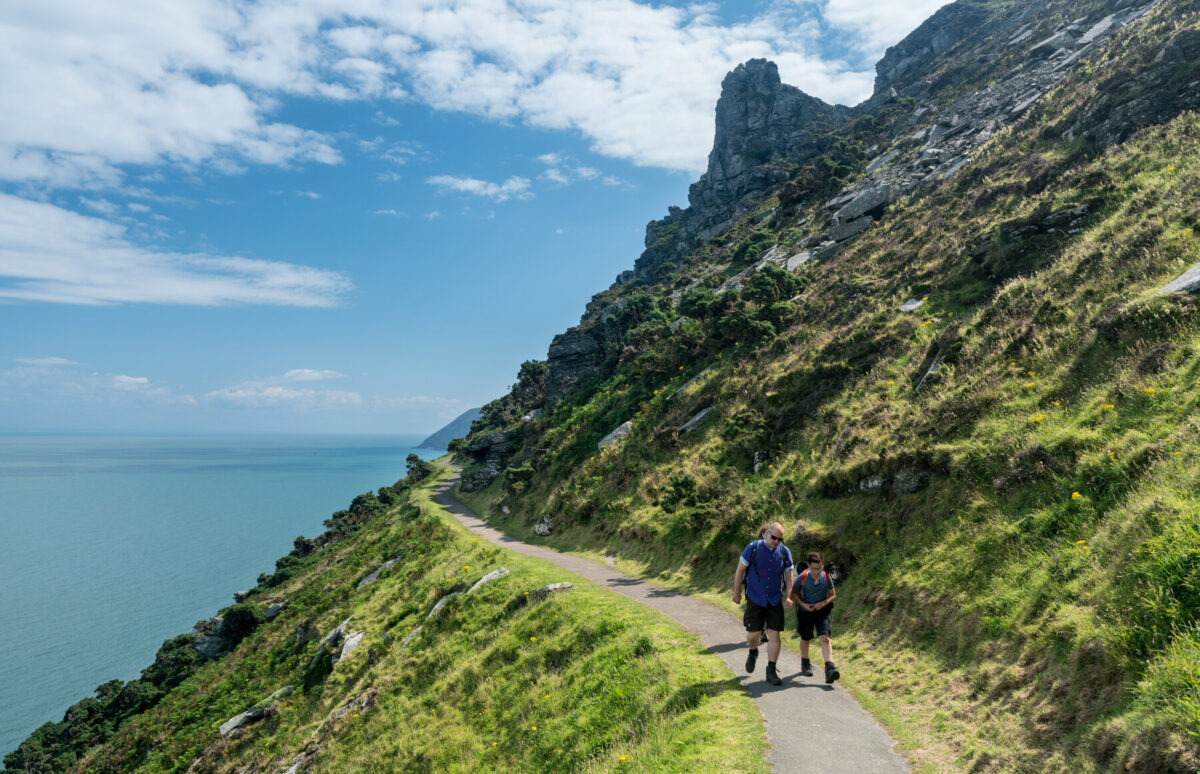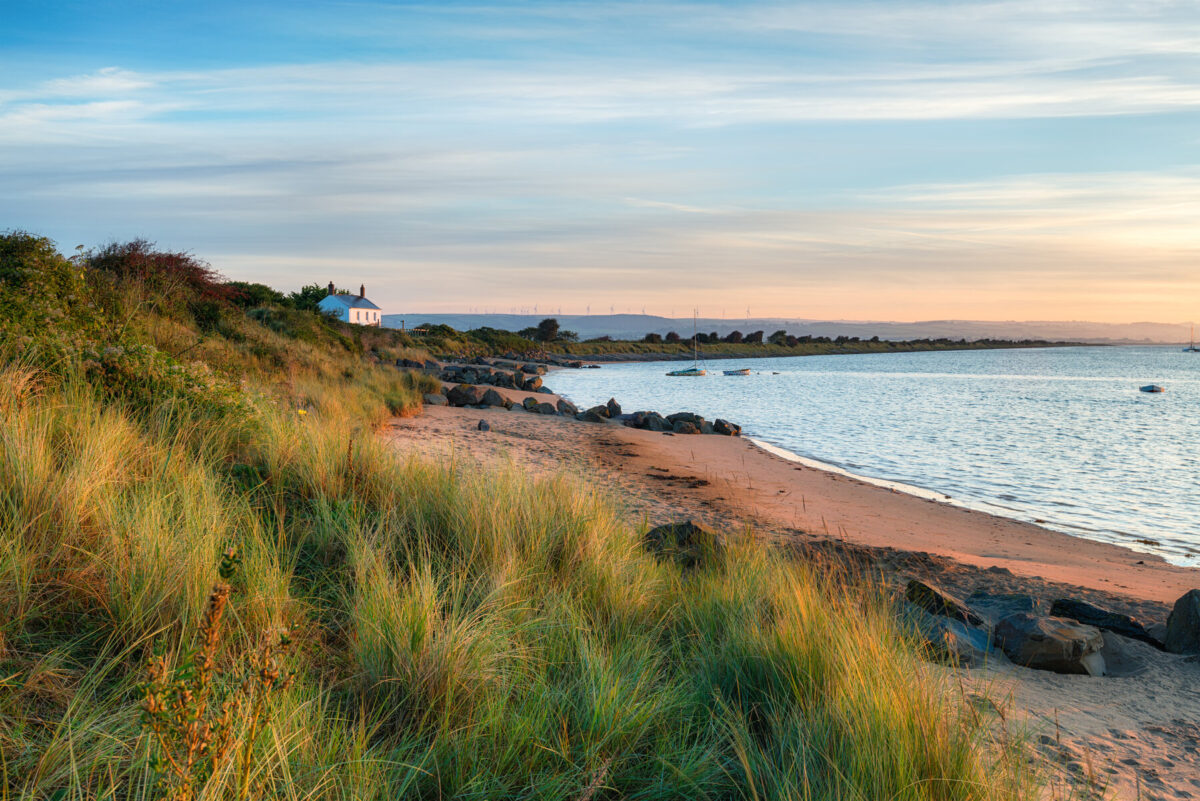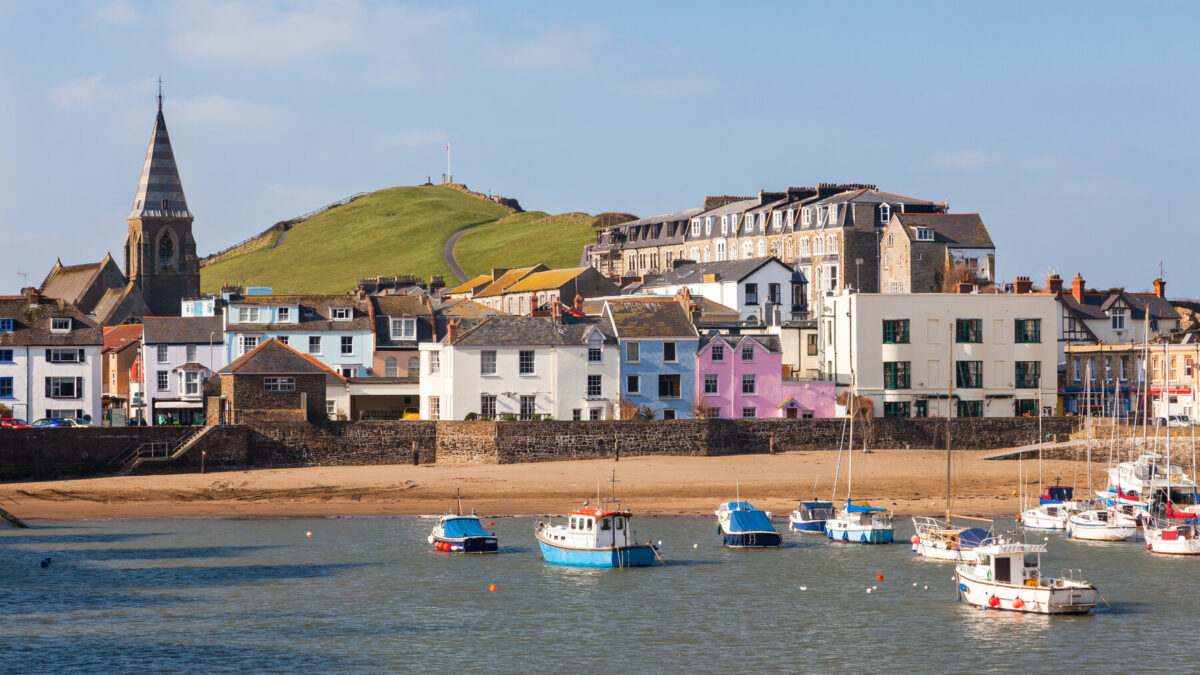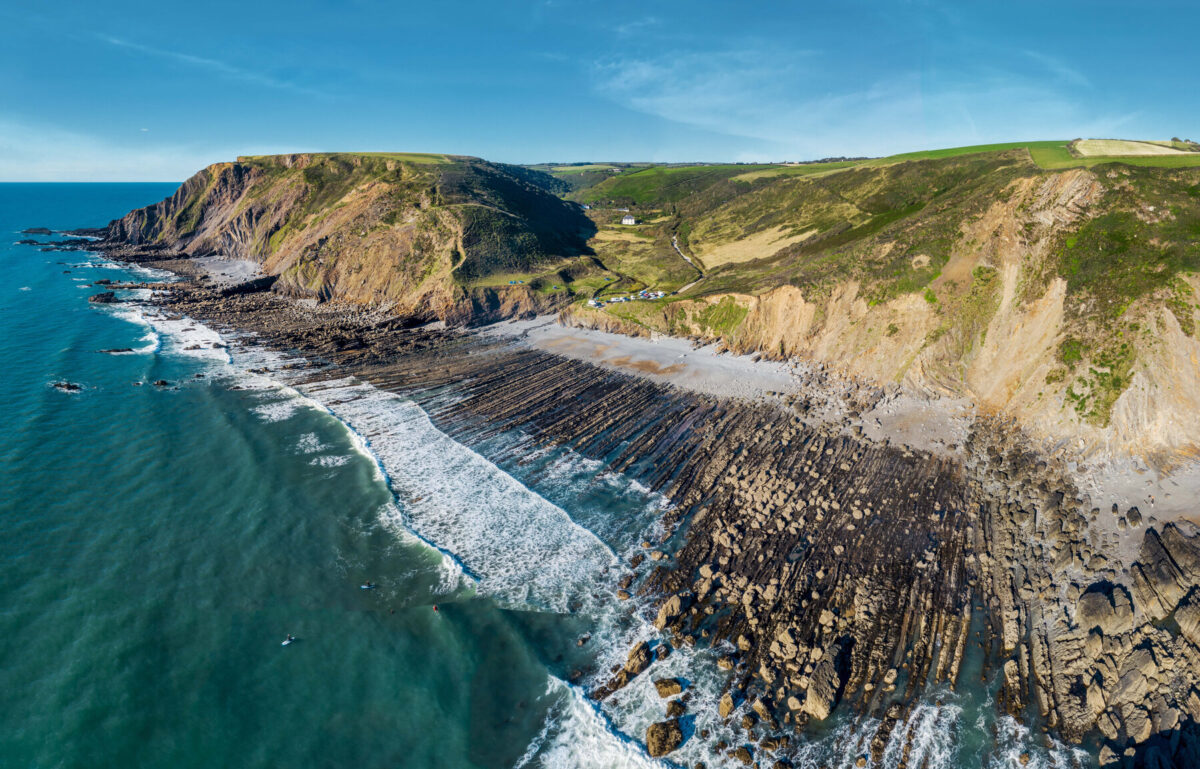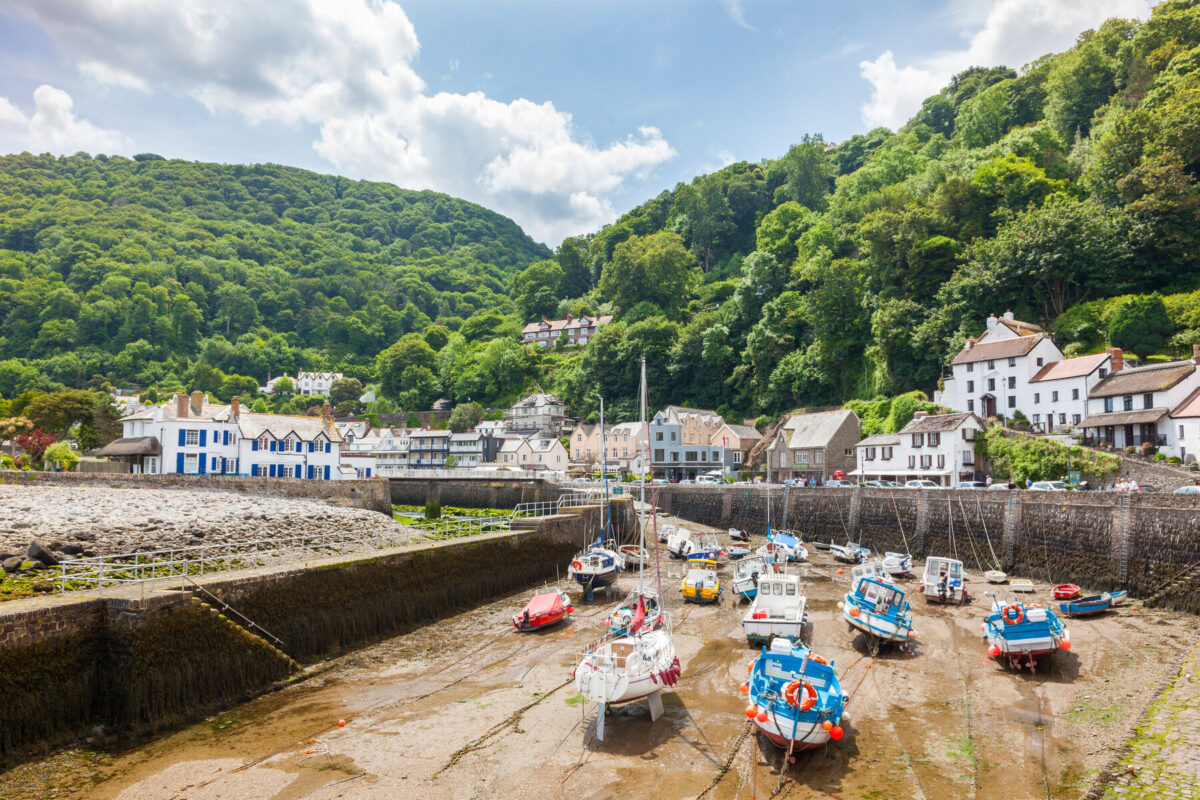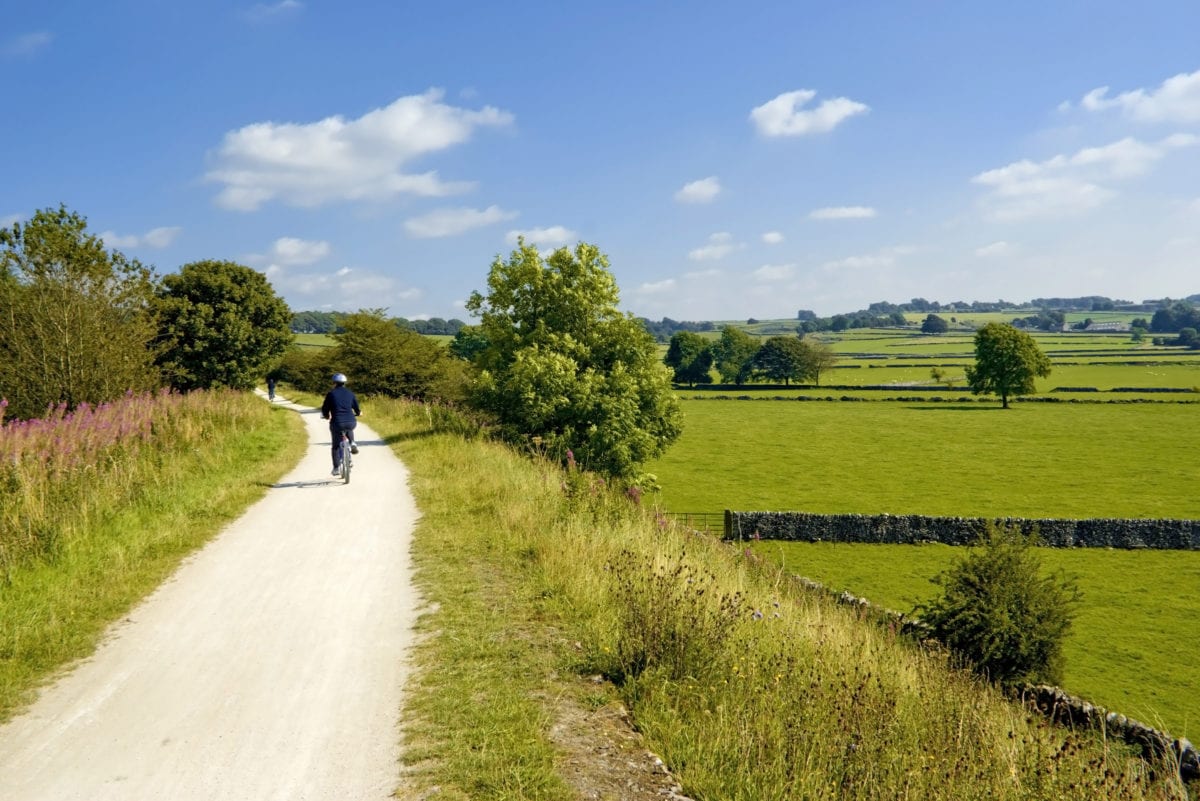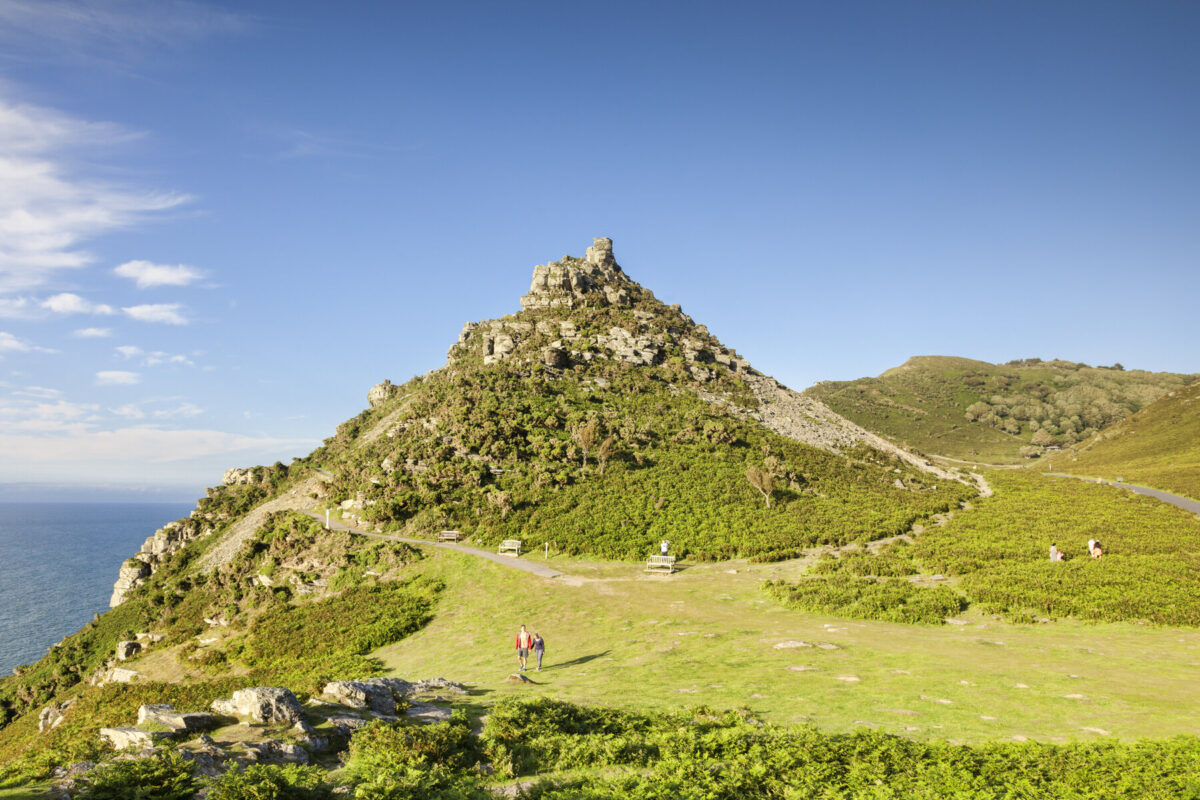We want visitors from afar to learn that there’s more to Devon than the beaches and commercial places that get into the tourist brochures.
Alistair & Gill Campbell authors of Slow Travel: North and Mid Devon, co-authored by Hilary Bradt
North Devon is one of our hot destinations for the year ahead – check out the full list of the best places to travel in 2024 here.
We have lived in the West Country for many years and one of the joys of researching Bradt’s Slow Guide is that it has made us appreciate North and Mid Devon anew. Walking coastal paths in glorious sunshine; discovering tiny churches and unsung villages; learning to blow glass, throw a pot or surf a wave – North and Mid Devon is surprisingly rich in its hidden delights.
North Devon is dominated by its coast and some parts become busy in high season. Head a little south into Mid Devon and the crowds evaporate away. Here you’ll find interesting places to stay, from a thatched cob cottage in a quiet village to a luxurious tree-house with a hot tub for two. Some attractions are well known, like the RHS’s gardens at Rosemoor but others, like Dingles Heritage Fairground just off the A30 and Woolley Animals at Winkleigh, are off the usual tourist trail.
This part of Devon is exceptionally appealing to foodies. Slow food is part of Slow travel and this region lends itself to time spent lingering over a meal in a thatched pub, a cream tea in a riverside tearoom or even a cocktail overlooking a beach at sunset. Whatever you eat and drink, it is likely to be local thanks to the farming heritage of the region, which encourages free-range animals and organic methods. It is probable that the gin in your cocktail also comes from just down the road thanks to the increasing number of distilleries cropping up in the area. North and Mid Devon has fourteen independent breweries, numerous cider mills and a handful of small vineyards.
Many visitors come to the area to walk. We first visited to walk the world famous South West Coast Path (SWCP); the North Devon section is probably the most beautiful (as well as the most challenging) part of the entire route. All keen walkers who visit Devon will do parts of the coast path, most utilising the inland footpaths to make a circular trip or taking a local bus to get to the start.
While you walk or drive you are bound to spot the wildlife – red deer, Exmoor ponies, foxes, badgers, buzzards and other birds of prey abound. If you take the boat to Lundy – it really is a must – between May and July you will see puffins, complete with their brightly coloured beaks.
Bradt on Britain – our Slow Travel approach
Bradt’s coverage of Britain’s regions makes ‘Slow Travel’ its focus. To us, Slow Travel means ditching the tourist tick lists – deciding not to try to see ‘too much’ – and instead taking time to get properly under the skin of a special region. You don’t have to travel at a snail’s pace: you just have to allow yourself to savour the moment, appreciate the local differences that create a sense of place, and celebrate its food, people and traditions.
For more information, check out our guide to North and Mid Devon
Food and drink in North and Mid Devon
Food
This part of Devon is exceptionally appealing to foodies. The abundance of fresh produce and excellent restaurants is largely due to the farming heritage of the region, which encourages free-range animals and organic methods.
The taste of Devon is undoubtedly that of clotted cream. A Devon cream tea is as integral a part of a visit to this region as rain (indeed, the one often leads to the other). Clotted cream is quite unlike any other sort of cream, being as thick as butter and almost as yellow; it contains more fat (around 63%, while double cream is 48%), and traditionally was made by gradually heating fresh milk using steam or hot water, and allowing it to cool very slowly. The thick cream that rises to the top was then skimmed off. The original term was clouted cream, clout being the word for patch, referring to the thick crust that forms when the cream is heated.
Clotted cream is served with fresh scones, which should be warm from the oven not the microwave; purists prefer plain scones but others love the fruit ones. In Devon the cream is spread on the scone first, instead of butter, and jam is added on top; in Cornwall it’s the opposite: jam first, then clotted cream. Either way it’s utterly delicious – and very filling. The Victorian prime minister William Gladstone was right when he called clotted cream ‘the food of the gods’. Talking of jam, an Exmoor speciality is whortleberry jam. Whortleberry is the Exmoor name for bilberry, a heather relative, which grows on the moor.
Meat eaters are in for a treat in this region. Some hotels convert to shooting lodges in the winter so pheasant, partridge, woodcock and venison feature on many country menus.
The native cattle could claim to produce the best steak in England. The nickname for the North Devon breed of cattle, Red Ruby, is appropriate: these animals are a beautiful chestnut red, the colour of a ripe conker. They are prized for their docility, hardiness and ability to convert grass to succulent, marbled meat. Most of the herds you will see grazing in the North and Mid Devon fields are grown slowly, outdoors (though the climate is such that they need to be brought inside during the winter), with the calves staying with their mothers until they are weaned.
Another native breed, the Exmoor horn sheep, has adapted to the conditions on Exmoor over the centuries. And Exmoor has adapted to the sheep, so the landscape you enjoy today owes as much to the grazing of these animals as it does to nature. The sheep are all-white and, as the name suggests, both rams and ewes have horns. They are dual-purpose animals, raised for wool as well as meat – in the days when mutton was regularly eaten they were considered to have the finest meat of any breed. Devon closewool sheep are another breed from Exmoor favoured for meat and hardiness.
Pigs, the original domestic meat animal, do well on Exmoor, and rare-breed Berkshire and Middle White pigs are raised outdoors (mostly) to provide succulent pork.
Drink
North and Mid Devon has 14 breweries listed by the Campaign for Real Ale (CAMRA). They are: Artbrew, Barum, Buckland, Clearwater, Combe, Country Life, FatBelly, Grampus, GT Ales, Holsworthy Ales, Magical Craft Brewery, Tally Ho!, Taw Valley and Yelland Manor. Quite a collection! See northdevon.camra.org.uk for more details.
There are also some interesting local ciders. Sandford Orchards in Crediton and Sam’s Cider in Winkleigh both produce excellent ranges – it’s fun finding your favourite. Cider making is seasonal, so if you are in Devon in late autumn you may see apples being collected for pressing. The juice is then fermented for 14 days and blended, which can take up to two years; Devon’s cider makers don’t hurry, they just want to make great cider. Similarly, there are a number of small vineyards that produce excellent English wine. You’ll find ales, ciders and wines in most farm shops and stores selling local products as well as in the producers’ own on-site shops.
If it’s the stronger stuff you’re after, there’s a number of excellent local gin distilleries in the region. Exmoor’s Wicked Wolf Gin is making a name for itself; it’s run by a husband-and-wife team in Brendon who are proud of the eleven premium botanicals that go into it. Likewise, the Atlantic Gin distillery on the North Devon coast uses ‘locally foraged botanicals’ including samphire and laver for their distinctive tastes. In a tiny distillery near Winkleigh, Dawn and Mark make Gotland Gin and they will happily show you how they do it, before you do some tasting in their outdoor, covered bar. Gin making is one of Britain’s fastest-growing industries so you will no doubt find other distilleries during your travels.
Where to stay in North and Mid Devon
For information about accommodation, see our list of the best places to stay in North and Mid Devon.
What to see and do in North and Mid Devon
Dingles Heritage Fairground
Just three miles south of Devon’s Roadford Lake is Dingles, a complete working fairground with rides dating from the 1920s to the 1970s and housed in two giant hangers. Never was a heritage centre so much fun. Music and coloured lights set the atmosphere as the riders scream on Moon Rocket, the ultimate 1930s white-knuckle ride, while Harry Tuby’s Victory Horses roundabout is a little more sedate – built in 1920, it is resplendent in its original colours and wooden horses.
Every ride has its own history, explained on an information board. The Ghost Train was built in 1947 and owned by Joe Stevens, son-in-law of Billy Smart of circus fame; it has its original decoration which contains some fantastic and amusing cartoon scenes. The Super Chariot Racer was one of the first white-knuckle rides and proved very popular in the 1930s, costing £1,750 to build. Decorated with a Roman chariot theme, it is as scary today as it was nearly a hundred years ago. Then there are the Super Dodgems which date from 1932 and toured England until 1980. A contemporary newspaper described the dodgems as ‘A game of indoor motoring, in which collisions call forth no bad language’.
There are so many rides, as well as traditional sideshows and even the caravans used by the showmen as they toured the country. In 2021 a new shop and café were added, much of the work being carried out by passionate volunteers. It is a wonderful place, we loved our time there and will be back; don’t miss it.
Lynton and Lynmouth
Without doubt this area is the most popular part of Exmoor – and deservedly so. It really does have everything, and all within walking distance: a pretty seaside village, a cliff railway, a tumbling river cutting through forested slopes, the heather-clad moor and a dollop of recent history. Painters and poets have rhapsodised about its beauty: Gainsborough thought it the perfect place to paint, and Shelley lived in Lynmouth for nine weeks with his first wife.
Writing in 1928, S P B Mais felt that: ‘Ordinary standards simply won’t do to describe this corner of Devon. One realises dimly and dumbly that no other combe of one’s acquaintance comes quite so obligingly near to the hotel door to show its beauty of wood or majesty of cliff.’
What to see and do
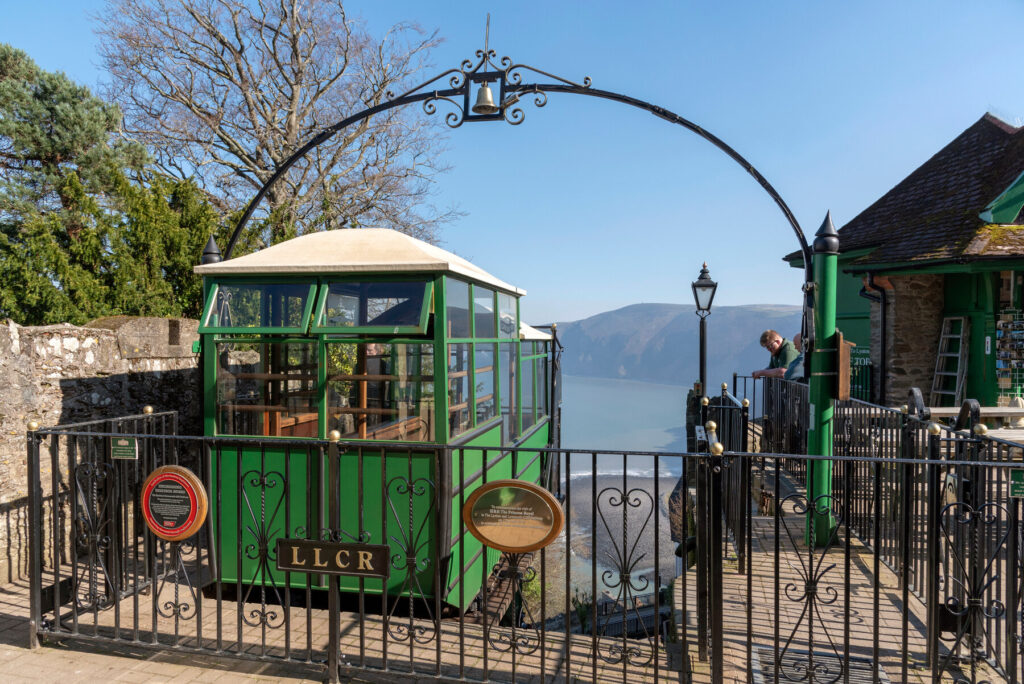
Lynton
Lynton’s sturdy Victorian houses and extraordinary town hall are surprising in a place that otherwise feels like a modern, upmarket holiday centre. The town hall is described in The Shell Guide of 1975 as ‘a jolly edifice, “15th century” stonework, “Tudor” half timbering, and “Flemish” barge boarding’. The former Methodist Church has been put to good use: the church itself houses the rewarding Lyn Valley Arts and Crafts Centre and the hall is now a cosy 70-seat cinema, a charming place run by volunteers.
Lynton has a particularly good selection of accommodation, most with superb views, and some excellent shops and restaurants. Even with such a range of craft shops the Arts and Crafts Centre, next to the town hall, stands out for its range of high-quality but affordable crafts, which includes preserves, honey and soap.
Notable shops include Lyn Candles on Lee Road, selling a huge range of the eponymous things with great enthusiasm, the Lynton Sheepskin Shop, also on Lee Road, with a comprehensive range, and John Arbon textiles down Queen Street with lots and lots of pure wool socks.
Linking Lynton and Lynmouth is the cliff railway, a masterpiece of simple engineering and a model of ‘green’ energy. The two carriages are counter-balanced by water. Fill the tank at the top, and it’s heavy enough to pull the other carriage up as it descends. We watched the ‘driver’ at the bottom judge the amount of water to let out to counterbalance not only the weight of the carriage but the passengers as well. Really neat, and a great way to get to the top of a 500ft cliff. The year 2015 marked 150 years of continuous operation. Dogs and bicycles are allowed. Before the road was built in 1828, tourists were transported to Lynton on donkeys or Exmoor ponies, as were all the goods arriving in the harbour.
Lynmouth
Most people staying in Lynton walk down to Lynmouth and take the Cliff Railway up. It’s a very pleasant, steepish stroll down, the path lit by solar-powered lamps donated by different organisations.
Lynmouth is clearly very much older than its partner and very pretty with its harbour, cliffs and wooded hillsides. Close to the Cliff Railway on The Esplanade in the western part of Lynmouth is The Pavilion and the Exmoor National Park Centre. It has a café, a well-stocked shop with maps and guides, displays of wildlife, webcams, an audiovisual presentation giving an overview of Exmoor and a microscope with which you can study marine creatures collected on a guided tide-pooling excursion.
Continuing to the harbour, you can take a boat trip to Valley of Rocks and Lee Bay or continue strolling and buy an ice cream from one of the dozen or so outlets.
The Lynmouth Flood Memorial Hall, on pedestrianised Lynmouth Street, houses two exhibitions. On the ground floor is the story of the famous lifeboat rescue of 1899, while the upper floor is given over to the great Lynmouth flood of 1952 when, after torrential rain on Exmoor, a wall of water carrying broken trees and boulders washed down the East and West Lyn rivers. It happened in the dead of night, with the electricity supply one of the first casualties, so all the terrified villagers could do was listen to the roar of the approaching torrent. Many houses were destroyed and 34 people lost their lives. As with all major disasters, this has its own conspiracy theory – that at that time the government was experimenting with cloud seeding.
Some visitors only get as far as the main street, Riverside Road, and the pedestrianised Lynmouth Street. This is a pity since beyond this, on Watersmeet Road, is a working pottery, Lynmouth Pottery, with a range of ceramics and some charming sculptures.
Watersmeet House
The less precipitous road to Lynmouth and beyond is Watersmeet Road, which takes you past one of the area’s most popular tea rooms, the National Trust-operated Watersmeet House. Most people walk here from Lynmouth but there is a (paying) parking area on the road above with a steep path down. Everything about this former fishing lodge is perfect: the choice of snacks and cakes, and especially the location.
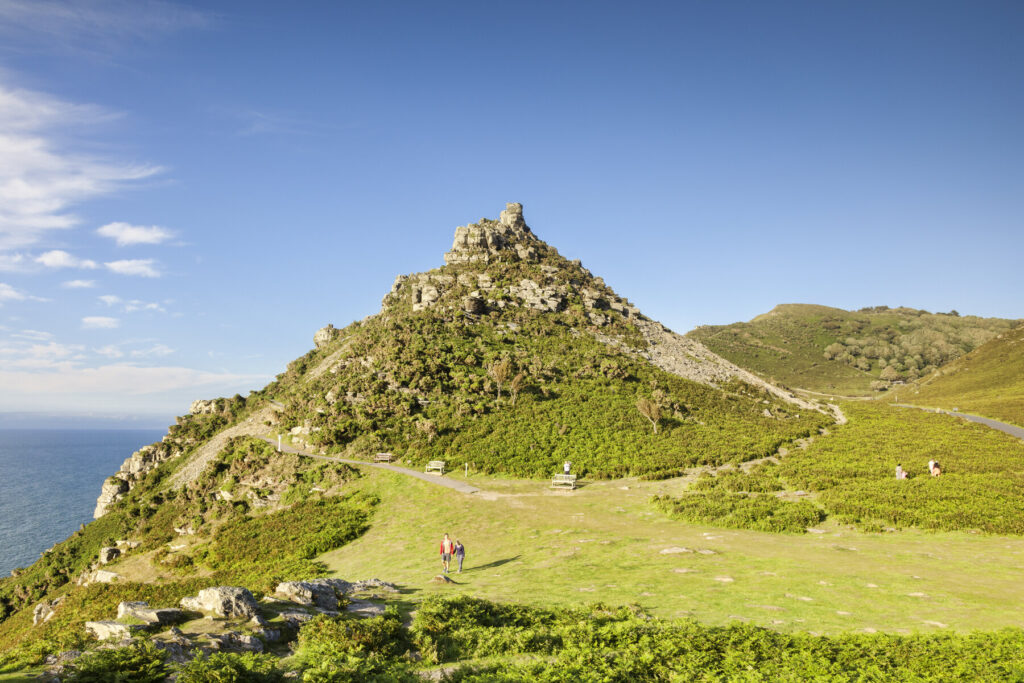
The Valley of Rocks
The Valley of Rocks is accessible by car, but it’s such a lovely walk that if you can it’s well worth doing on foot from Lynton. The valley, which would be unexceptional on Dartmoor, is quite extraordinary on Exmoor where the soft sandstone has left few sharp contours. The most likely explanation for these heaps and castles of rock is that this was once a river valley, the boulders being deposited during the ice age, before the river changed its course. Glaciation and weather erosion did the rest.
The place was already well known when R D Blackmore wrote Lorna Doone in the 1860s. The hero John Ridd goes there to consult a wise woman, noting that ‘foreigners, who come and go without seeing much of Exmoor, have called [it] the “Valley of Rocks”.’ The rocks already had their names: ‘On the right hand is an upward crag, called by some “The Castle”, easy enough to scale… Facing this, from the inland side and the elbow of the valley, a queer old pile of rock arises, bold behind one another, and quite enough to affright a man, if it only were ten times larger. This is called the “Devil’s Cheese-ring” or the “Devil’s Cheese-knife” which mean the same thing, as our fathers were used to eat their cheese from a scoop; and perhaps in old time the upmost rock… was like to such an implement if Satan ate cheese untoasted.’
Putsborough and Woolacombe Sands
Between the two horns of Baggy Point and Morte Point is Morte Bay and the 2½-mile stretch of sandy beach that makes up Putsborough Sands and Woolacombe Sands (the two morph into each other).
Woolacombe Sands has been voted one of Britain’s best beaches, so it’s not surprising that it is so popular with families visiting North and Mid Devon. There’s room for everyone along this expanse of golden sand and white surf, and in the several holiday parks for camping and caravans. But tucked into recesses on the southern face of Morte Point are smaller, less crowded beaches, as well as a gorgeous headland walk.
Putsborough is the southern, more isolated, end of the beach, sheltered from west winds by Baggy Point, with rock pools and fewer amenities than Woolacombe Sands (and there is no lifeguard) so perhaps more appealing to adult Slow visitors. There’s a dog-free area but otherwise it’s dog-friendly, and the café serves good food. The carpark is expensive (as they all are in this region) but if you park at the NT place in Croyde and walk over Baggy Point you can get the best of all worlds.
Woolacombe Sands came into its own during the Victorian period when sea-bathing became all the rage and the large houses and hotels that we see today were built. The beach is privately owned and deserves its accolades. It has ample carparking close by, clean loos, plentiful refreshments including fish and chips, and is cleaned daily. Beach huts can be hired for the day. Lifeguards are on duty and there is a doggy stretch as well as a dog-free area in the summer. And there are tide pools. For families it really is ideal.
RHS Garden Rosemoor
The RHS’s showpiece garden, Rosemoor, has 65 acres with 200 varieties of rose. And that’s just the beginning – there’s every plant imaginable and every colour in the spectrum. There are vegetables galore, soft fruit, orchards and woodland walks. It takes a while to see it properly; the highlights are all accessible within an hour or so, but if you can spend the day here, do. Any visitor to Devon with an interest in flora will certainly not regret it.
Come here on a sunny day, any time of the year, and take your time to breathe in the scents and sights. The knowledge of your fellow visitors can be intimidating: on my last visit a voice boomed out: ‘Did you tell Daddy about the pelargonium?’. The child looked about five.
The RHS runs daily events and exhibitions, as well as courses, and the Reading Room is open to non-members who can browse the 1,300 reference books. The award-winning Garden Kitchen serves hot meals (see opposite) while the Wisteria Tea Room, part of Lady Anne’s House, is open in the summer.
Plant lovers must visit The Cool Garden, The Model Gardens, The Winter Garden and The Cherry Garden. Beyond the flora and fauna, visitors can take a stroll to the Bicentenary Arboretum or the Stumpery, a sculptural backdrop of gnarled tree limbs and small stumps.
The Tarka Line
The scenic 39-mile Tarka railway line bisects the heart of Devon, running from Exeter to Barnstaple and following the gentle river valleys of the Yeo and Taw. The line’s 13 stations offer great opportunities to explore the area, giving access to several historic villages including Eggesford’s forests and walking trails, Chulmleigh with its unusual architecture and ancient buildings, and Lapford with its strong community and ghost stories.
The southern end of the Tarka Line serves the town of Crediton, which sits at the confluence of the River Yeo with the River Creedy. Its location in the centre of great farming land plus good transport links to Exeter and the M5 has lead to the establishment of many local food industries – cider mills, breweries, creameries and dairies.
It is amazing that the Tarka Line still exists, let alone thrives, as its building was beset with difficulties. In the early 19th century, rail companies were competing to build new railways all over England. Two rail routes to Barnstaple were proposed as early as 1831 – one from Exeter via Crediton and the other from Tiverton via Bideford. The latter was favoured by the government and Isambard Kingdom Brunel was recruited as its engineer. However, the company failed to meet parliament’s deadlines and, in 1845, the Exeter route via Crediton won the day.
There then followed years of argument over the gauge of the railway and funding became an increasing issue. After years of ‘railway mania’ when money was no problem, investors’ enthusiasm had declined and money was hard to come by. Work first started on the Exeter to Crediton passenger line nearly six years after getting parliamentary approval, with the first trains departing from Exeter in 1851. Work on the line from Crediton to Barnstaple began later that year and this extension opened three years later.
The line was taken over by Great Western Railways in 1876 and then nationalised in 1948. Despite many railways being closed in the 1960s, the Barnstaple to Exeter route survived, the only remaining rail line out of Barnstaple. Fearing for its future, local organisations rallied to support the line and it was one of the first to be given an identity as a tourist railway, sponsored by North Devon tourist board.
Today, the Tarka Line is operated by First Great Western, and the number of passengers has trebled in the last 20 years.
Related books
For more information, see our guide to North and Mid Devon:
Related articles
From casual village strolls to breathtaking coastal hikes.
From gypsy caravans to safari-style tents.
From luxury accommodations to simple family-style boutiques.
From working farms to coaching inns.
From nature reserves to converted manor houses.
Leave the car behind and explore Britain’s highways, byways and coastal pathways on two wheels.
Whether you are looking for a bench with a view or a grassy meadow with a stream, you can find it on Exmoor.
